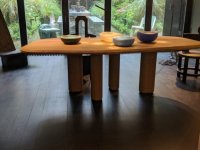ear3
Member
- Joined
- Jul 24, 2014
- Messages
- 4,341
I'm working on a table commission that involves large, oval-shaped legs (4" x 5 1/2") similar to these:
[attachimg=1]
[attachimg=2]
I don't currently have a tool that would cross cut something that thick to length, so I'm thinking I'll take this opportunity to invest in a beam saw (unless there are other suggestions for how to cut something like this accurately).
I'm not going Mafell, so it looks like the two main options are the Makita 5402 and the Skilsaw Super Sawsquatch. It seems that both are comparable in power, so my main need is accuracy and as dead square a cut as can be achieved with a tool like this.
Other than this project, down the road I do have a deck build where this saw would presumably get used to cut 4x4s and 6x6s to length.
There's an online head to head review that seems to favor the Skilsaw, so I am currently leaning in this direction:
Anyone have experience with these saws and/or a marked preference?
[attachimg=1]
[attachimg=2]
I don't currently have a tool that would cross cut something that thick to length, so I'm thinking I'll take this opportunity to invest in a beam saw (unless there are other suggestions for how to cut something like this accurately).
I'm not going Mafell, so it looks like the two main options are the Makita 5402 and the Skilsaw Super Sawsquatch. It seems that both are comparable in power, so my main need is accuracy and as dead square a cut as can be achieved with a tool like this.
Other than this project, down the road I do have a deck build where this saw would presumably get used to cut 4x4s and 6x6s to length.
There's an online head to head review that seems to favor the Skilsaw, so I am currently leaning in this direction:
Anyone have experience with these saws and/or a marked preference?


